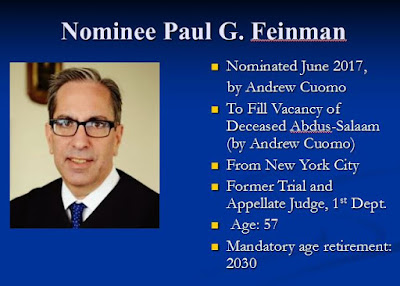Feinman had been elevated to the Appellate Division by Cuomo in 2012. He was the first openly gay man to sit on that court and, if confirmed by the state senate, he will be the fist openly gay Judge on the Court of Appeals.
(At this time, the Senate Judiciary Committee has not yet scheduled a hearing. The Senate itself finishes its session and departs next Wednesday, June 21.)
Feinman was selected by Cuomo from the list of seven provided to the Governor two weeks ago by the Commission on Judicial Nomination. At the Governor's urging, the Commission completed its business in very short order. Beginning April 14, upon the official notification of the vacancy created by the sudden death of Judge Sheila Abdus-Salaam, the Commission began soliciting applicants, conducting interviews, and producing a list of possible nominees. Instead of the statutory allowance of 120 days, the Commission finished its work in just 1 1/2 months.
Justice Feinman is a graduate of Columbia University and the University of Minnesota Law School. He spent the fist several years of his with the Legal Aid Society of Nassau County and New York. He then served several years as a law clerk to a judge who sat on state Supreme Court (i.e., trial court) and then on the Appellate Division.
In 1996 he was elected to NYC Civil Court and was reelected in 2006. In 2004, he was selected by then-Chief Judge Jonathan Lippman to serve as an Acting Justice of Supreme Court (highest trial court) Three years later, he was elected to that court and, in 2012, Governor Cuomo elevated him to be a Justice of the Appellate Division.
In short, Feinman has spent a career in government, all of it arguing or serving in and on courts. Beyond that, he has been very active in judicial and bar groups. He has, for example, served as the president and then chair of the supreme court justices association, and as the president of LGBT bar and judicial groups.
Feinman is 57 years old, born in January 1960. Under New York's (moronic) mandatory age-70 retirement for Court of Appeals Judges, he will be able to serve for 13 years of the full 14 year term, retiring at the end of 2030.
Notably, if and when Justice Feinman is confirmed, the composition of the Court of Appeals will include:
1 African-American Judge (Judge Rowan Wilson),
2 Hispanic Judges (Judges Jenny Rivera and Michael Garcia),
3 Women (Chief Judge Janet DiFiore and Judges Rivera and Leslie Stein),
1 Openly Gay Judge (Judge Feinman),
2 Upstaters (Judges Stein [the Capital Region] and Eugene Fahey [Buffalo]),
2 From New York City (Judges Rivera and Feinman [Also, Judge Garcia was born in the City and nominee Wilson works there.]),
2 Who live just north of the City in Westchester County (Chief Judge DiFiore and Judge Garcia),
1 Who lives on Long Island (nominee Wilson),
3 Who were appellate judges (Judges Stein, Fahey, and Feinman),
4 With experience as trial judges (Chief Judge DiFiore and Judges Stein, Fahey, and Feinman),
2 From private practice (Judge Garcia and Wilson),
2 Prosecutors who ran prosecutorial offices (Chief Judge DiFiore [Westchester County District Attorney] and Judge Garcia [U.S. Attorney for the Southern District of New York]),
1 Academic (Judge Rivera),
6 Different law schools (St. John's [DiFiore], Columbia [Abdus-Salaam], Albany [Stein and Garcia], SUNY Buffalo [Fahey], Harvard [Wilson]), and Minnesota [Feinman],
1 Italian-American (Chief Judge DiFiore), 1 Puerto Rican-American (Judge Rivera), 2 Jewish-Americans (Judges Stein and Feinman), 1 Irish-American (Judge Fahey),
1 Republican (Judge Garcia),
6 Democrats (All the rest).
3 Women (Chief Judge Janet DiFiore and Judges Rivera and Leslie Stein),
1 Openly Gay Judge (Judge Feinman),
2 Upstaters (Judges Stein [the Capital Region] and Eugene Fahey [Buffalo]),
2 From New York City (Judges Rivera and Feinman [Also, Judge Garcia was born in the City and nominee Wilson works there.]),
2 Who live just north of the City in Westchester County (Chief Judge DiFiore and Judge Garcia),
1 Who lives on Long Island (nominee Wilson),
3 Who were appellate judges (Judges Stein, Fahey, and Feinman),
4 With experience as trial judges (Chief Judge DiFiore and Judges Stein, Fahey, and Feinman),
2 From private practice (Judge Garcia and Wilson),
2 Prosecutors who ran prosecutorial offices (Chief Judge DiFiore [Westchester County District Attorney] and Judge Garcia [U.S. Attorney for the Southern District of New York]),
1 Academic (Judge Rivera),
6 Different law schools (St. John's [DiFiore], Columbia [Abdus-Salaam], Albany [Stein and Garcia], SUNY Buffalo [Fahey], Harvard [Wilson]), and Minnesota [Feinman],
1 Italian-American (Chief Judge DiFiore), 1 Puerto Rican-American (Judge Rivera), 2 Jewish-Americans (Judges Stein and Feinman), 1 Irish-American (Judge Fahey),
1 Republican (Judge Garcia),
6 Democrats (All the rest).

